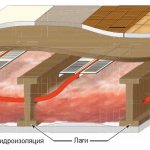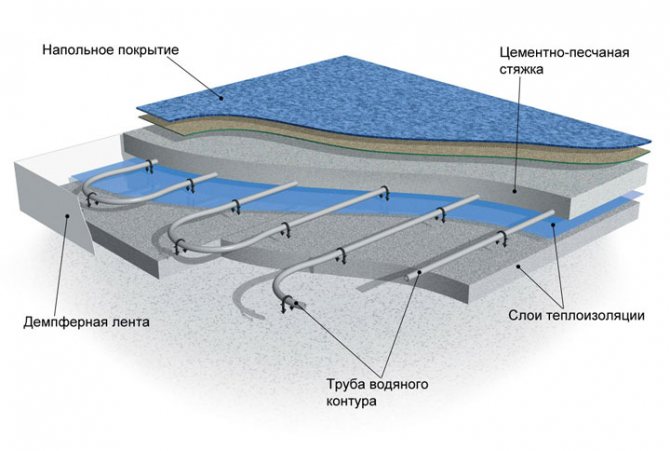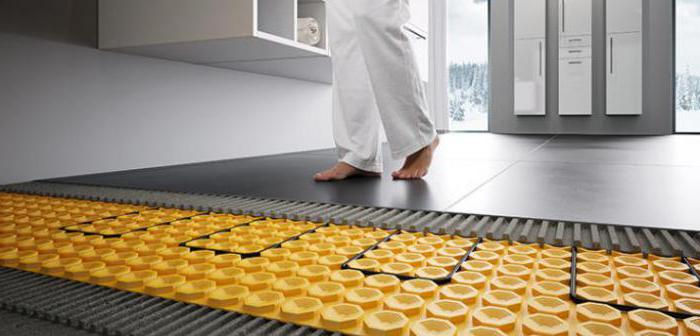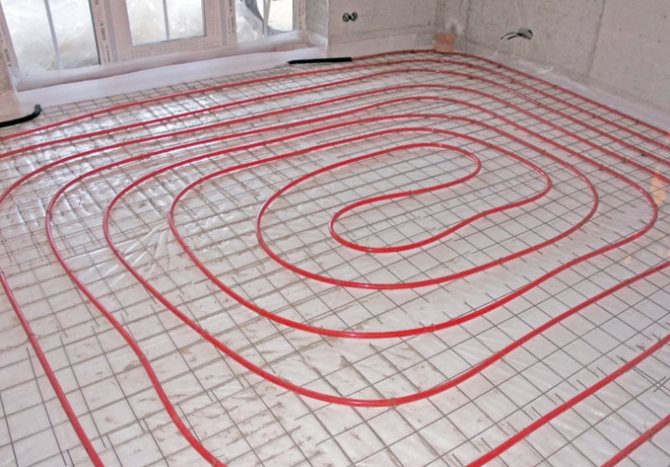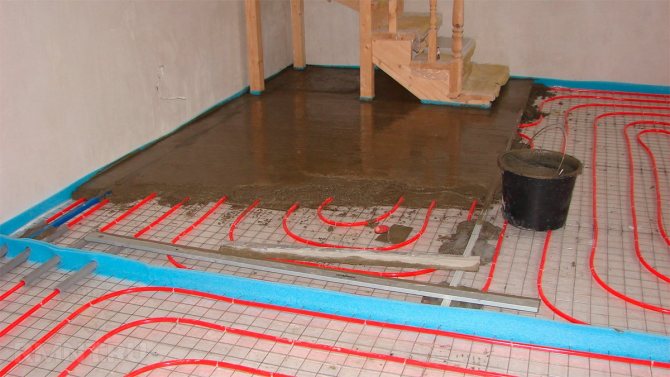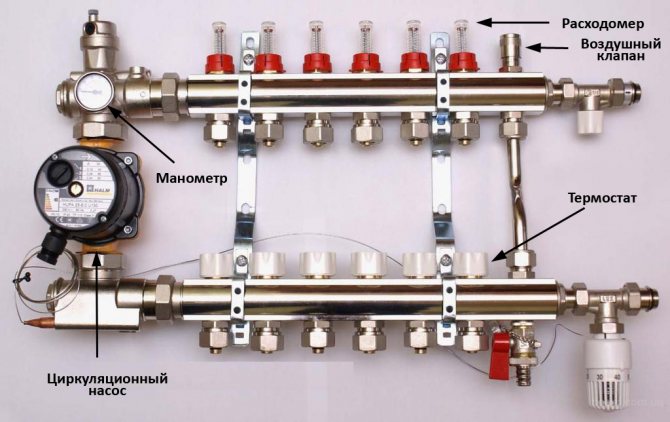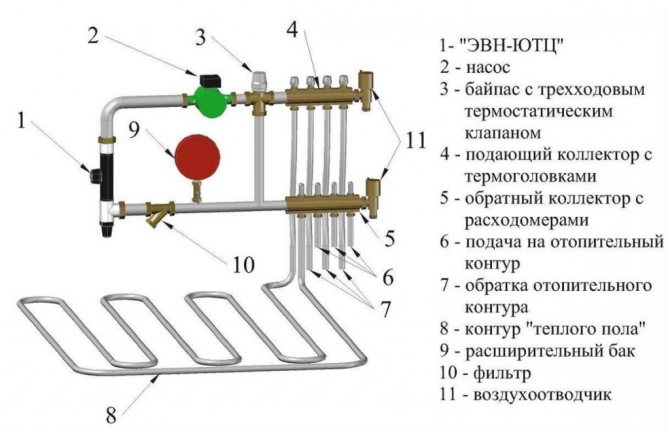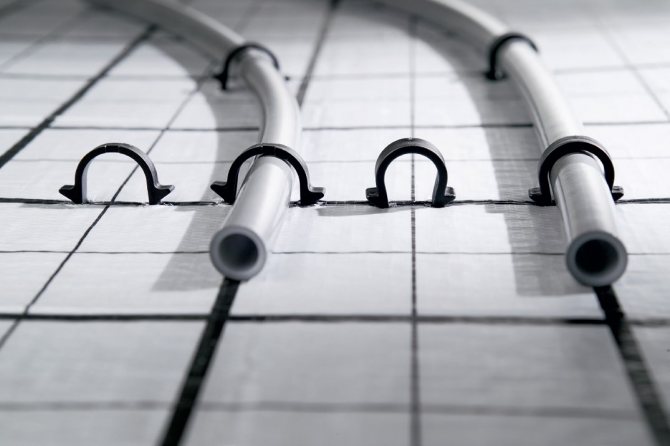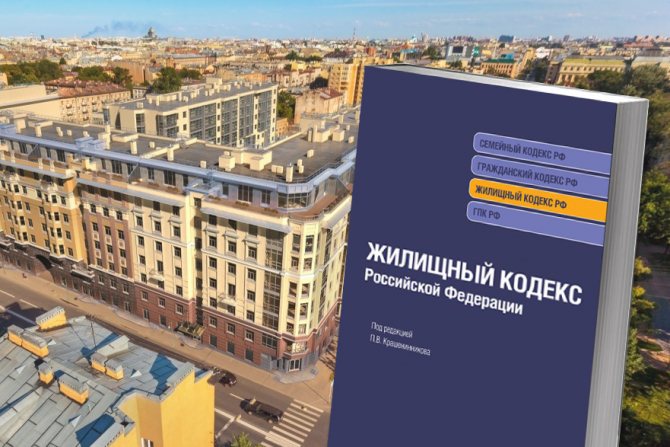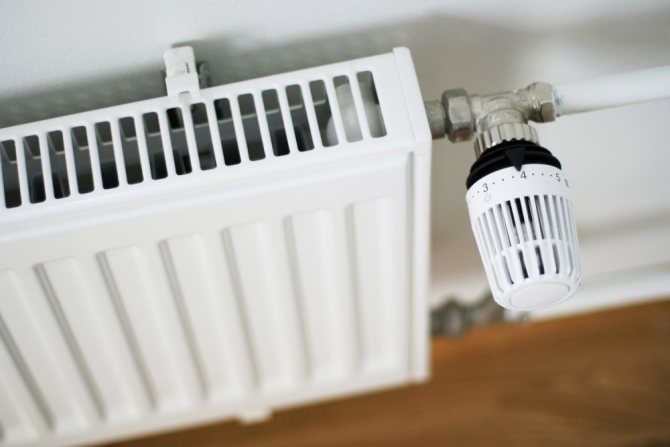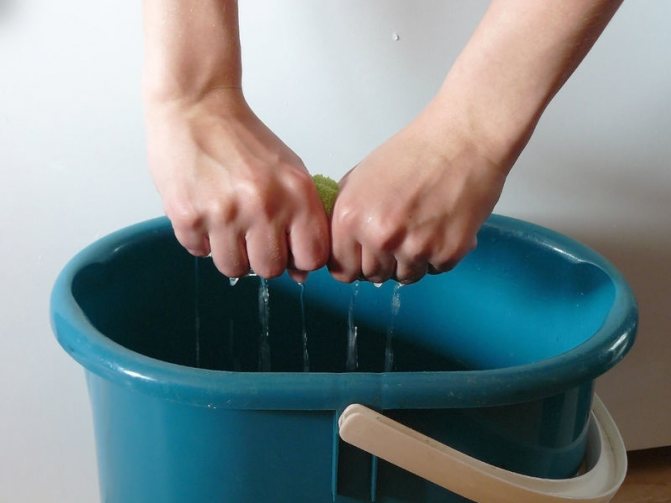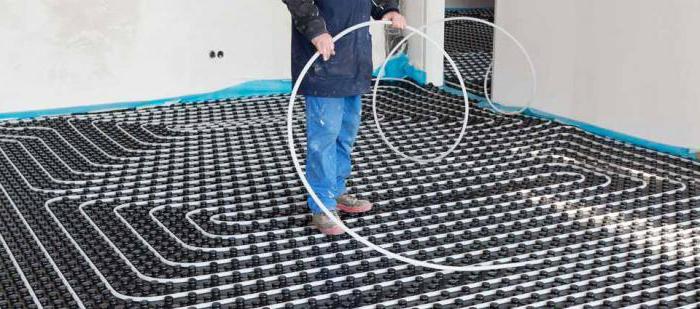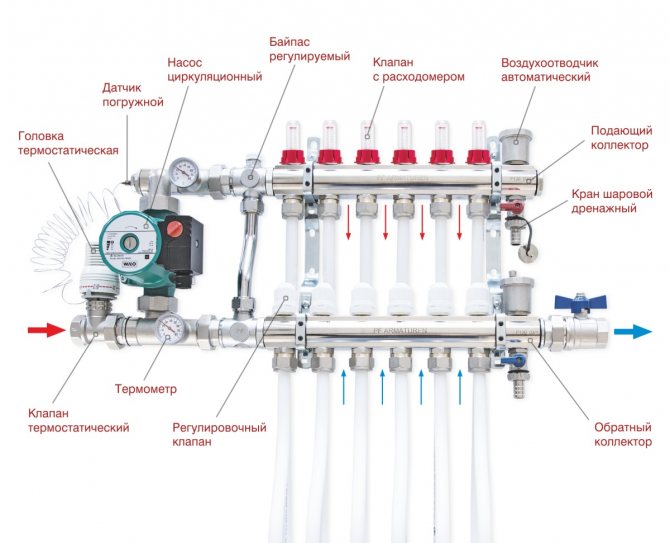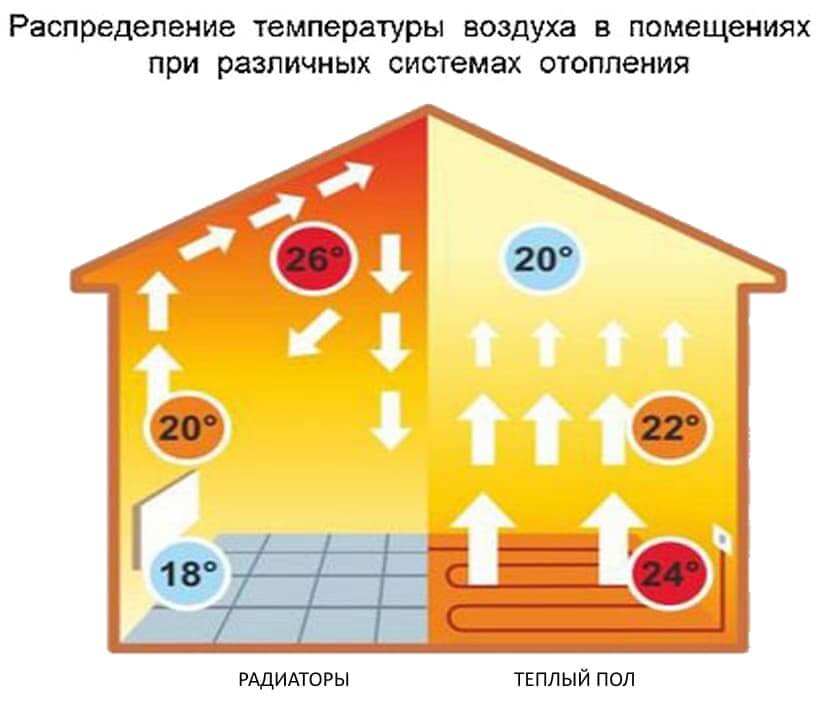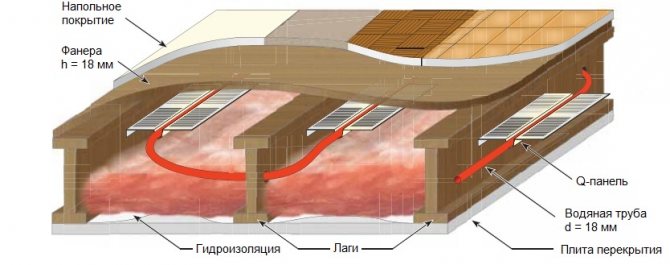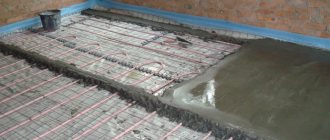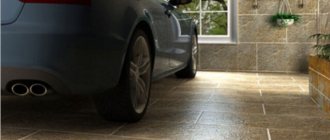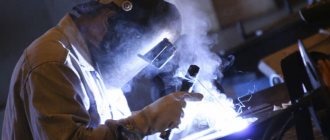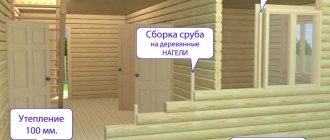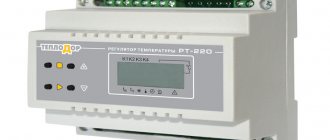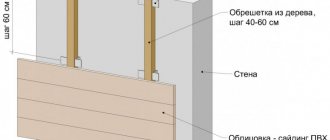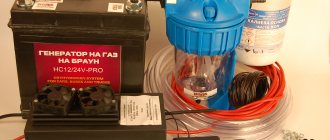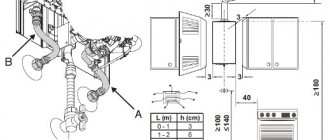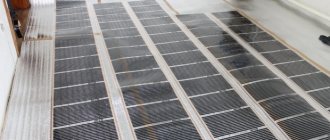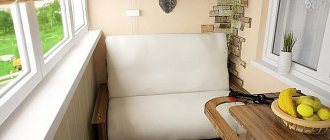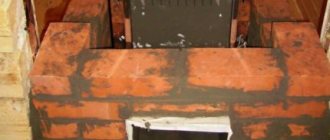Water underfloor heating device
At its core, a hydraulic floor is pipe systemthrough which a liquid of a certain temperature circulates. Heating is performed by a boiler, the design of which can include pump... Otherwise, it can be output separately. The pump is used to pump cooled water into the heating device.
At the entrance to the boiler, it is mandatory to install pressure gaugeallowing you to control the pressure in the heating system. Hot water enters the piping system through collector... It also serves to drain the liquid.
The collector is a piece of pipe with two types of splitters: for hot and cooled water. The manifold includes emergency drain systems, adjustments and settings of the system operation, valves that prevent the reverse flow of liquid.
Laying fine flooring
When the screed is dry, or the installation on the joists is made and pressed, you can proceed to the clean flooring. What to look for here:
- Ceramic tiles laid on a screed are ideal for underfloor heating. But for obvious reasons, it cannot be laid over the entire area of the house.
- If water-heated floors were mounted under a wooden floor (on logs), then plywood or OSB sheets should be fixed on top as a subfloor. For the best effect from the system, holes can be drilled in wooden floors so that warm air can escape better from under the floor.
- Almost any materials for the floor can be used. But it is worth buying only coverings intended for a warm floor, otherwise, when heated, the materials will evaporate harmful substances. Therefore, choose linoleum, laminate or cofrolin, only with a high environmental class and specially designed for warm floors.
- The tiles are laid directly on the screed, without any special features.
System mounting technology
Self-styling includes several stages: screed (or leveling), laying heat-insulating and waterproofing layers, distributing pipes, installing a floor heating collector, installing a water heater (boiler), installing pipes, pouring a screed.
All types of work must be carried out in compliance with sanitary standards and safety rules.
Each component structure must have appropriate pressure resistance indicatorsexposed to liquid or steam.
At every stage, it is necessary leak test and the durability of all devices.
Each scheme of a water heated floor can have its own distinctive features, depending on the type of room chosen (bath, balcony, living room), as well as the main material of the floor covering (tile, wood, plastic, concrete screed).
These nuances and detailed descriptions of each stage of installation are presented below.
Don't know how to glue non-woven wallpaper with your own hands? Read the detailed instructions.
Details on how to level the walls with putty can be found here.
How to apply latex water-based paint for walls, read this address: https://ru-remont.com/materialy/kraski/lateksnaya-vodoemulsionnaya-kraska.html
Waterproofing and screed
You can protect the floor from leaks by installing high-quality waterproofing... It is necessary to use a special film as a base. Usually it is rigid PS on boards or rolled PE.
The main thing is to make sure that all debris is removed from the surface. And only after that you can move on to the film itself.
Screed call the foundation on which the floor will lie in the future. In principle, a screed is not necessary if the old flooring was lying directly on the base slabs. It should be borne in mind that any screed raises the floor level.
Screed level first tagged with construction tools... For example, a laser level. Depending on the resulting parameters, the stock of pipes is calculated, which will be needed in the future. Beacons will need to be mounted to be visible. If the room is rather small, then this is not necessary. Next, building materials are laid. In the future, cement mortar is leveled along the lighthouses.
When the screed is dry, it will be necessary mark up according to where the pipes will be. In order to purchase a sufficient amount of material, the pipe laying scheme must be calculated in advance. The main thing is to comply with several requirements.
- Pipes must not be laid where there is or there will be furniture.
- The distance between the pipes must be at least 35-40 centimeters, the distance from the walls is 20-25 centimeters.
- A pipe extending from the riser should be laid under the windows.
Heat must be dissipated away from the surface of the pipes to the interior of the room. For this, a special screen is arranged in the structure. It is enough to lay the insulation, which has foil surface... At the joints, it is fastened with metal tape.
For underfloor heating, they are best suited seamless pipes made of metal-plasticwith a diameter of 25, 20 or 25 millimeters. With an increase in diameter, the level of the floor also increases. It is better to avoid polypropylene pipes, since they give off heat poorly and have low thermal conductivity.
For installation, a previously prepared diagram is used. If you need to make a bend, it is advisable to use spring with suitable diameter... This will protect the pipe from damage. As a result, the system must be fixed to the screed surface. For this, special plastic fasteners are most suitable. After fixing, you can connect everything to the riser.
Base leveling
The leveling process required in the presence of irregularities is always accompanied by complete removal of the old screed, cleaning of dirt, dust from construction debris.
For horizontal differences exceeding 10 mm, the procedure is mandatory.
The procedure can be performed Dry and Wet way. In both cases, the first step is getting rid of holes and cracks with the help of concrete mortar or other construction mixture intended for this.
With the "dry" method, the following works are carried out:
- On high 20 cm from the existing floor level, a mark is made around the entire perimeter of the room.
- Polyethylene and cellulose paper are laid on the floor with a wall 5-6 cm above the mark. If the material is a strand rather than a solid sheet, it must be placed with an overlap 15-20 cm. Along the perimeter, it must be attached to the wall with an edging tape planted on double-sided tape.
- A reinforced mesh is placed on the waterproofing material.
- Expanded clay is poured onto polyethylene, consisting of stones of different diameters. It is leveled with guides and compacted. The control of the uniform distribution of bulk material over the surface can be carried out using beacons or wooden slats.
- At the end of the work, the protruding polyethylene is cut off with a clerical knife.
You need to start alignment from the far corners, moving to the front door. If during the work projections or depressions are found, you can get to them with the help of "construction islands" - sheets of GVL.
When using the "wet" method, after removing the old screed, a primer is poured onto the floor and leveled with foam rollers. It takes up to 5 hours to dry. The next procedure is similar to the "dry" method, the only difference is the use of water when compacting expanded clay.
Calculation of the warm floor in the apartment
Before starting the calculation, decide on heat losses and if you need a pipe with a large pitch, feel free to make a pipe pitch of no more than 150 mm ..
Do not forget that serious loads must not be placed on the floor slabs.
The total cost of a water-heated floor in an apartment is determined by the area of the room, the equipment, the quality of the material and the method of work. Batch formation of a warm floor ensures the compatibility of the elements and effective heating in the temperature ranges. Factory equipment reduces the cost of materials by 1.5-2 times. To obtain accurate calculations, you need to contact a specialist.
How pipes are laid
Polystyrene boards are laid on the leveled floor surface. They serve for thermal insulation and prevent the spread of heat in all directions.
The actual pipe laying is carried out in two main ways: bifilar (parallel rows) and meander (spiral).
The first variety applies when there is a slope of the floors, there is no need for strictly uniform heating. The second - requires a lot of effort and accuracy, is used when using pumps of lower power.
The number of contours depends on the size of the heated room. The maximum area for placing one contour - 40 sq m. The laying step can be either uniform throughout its entire length, or vary depending on the need for enhanced heating in certain areas. Average stride length is 15-30 cm.
Since the pipes experience strong hydraulic pressure, when installing a water-heated floor, it is unacceptable to connect them using couplings. Only one coupling can be used for each circuit.
It is recommended to use one circuit for heating each room, including a bathroom, a loggia, a pantry, a shed. The smaller the contour, the higher its heat transfer, which is especially important for corner rooms.
Installation of a warm water floor
Any warm water floor system consists of such basic elements as pipes, as well as the technology for fixing them. As a rule, they use two methods:
- By dry method, using wood and polystyrene, which form the basis on which the pipes are laid. To distribute the heat more evenly, the pipes are also laid evenly, in the grooves specially provided for this. After that, a rigid material is laid on top of the pipes, such as plywood, OSB, gypsum fiber board, etc. The solid base is suitable for the installation of floor coverings of any origin.

Wooden water floor heating system - Wet method, which is associated with laying the pipe system in a screed. The technology consists of several layers. The first layer is insulation with a pipe fixing system, the second layer is the heating system itself and the third layer is the screed. The floor covering is laid directly on the screed. It is advisable to provide a layer of waterproofing so as not to flood the neighbors from below. For greater reliability, a reinforcing mesh can be built into the screed. The whole system will turn out to be more reliable, since the reinforcement will prevent cracking of the screed, which, in turn, will protect the heating system from damage. The presence of a damper tape should not be ignored, which should be present around the perimeter of the room, as well as at the junctions of two circuits.

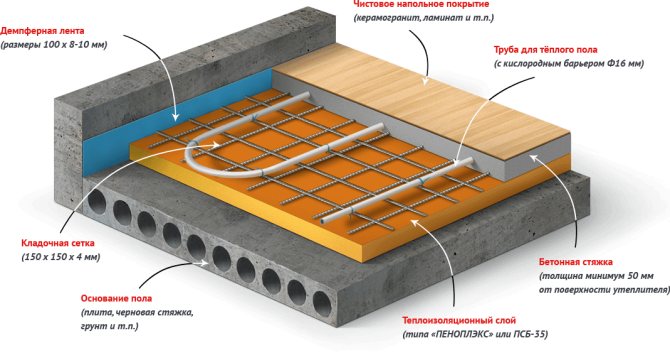
Water heat-insulated floor in a screed
Neither system can be called ideal, although laying pipes in a screed is considered a more optimal option, therefore, most people prefer this technology.
System selection
When choosing a system, a number of factors need to be analyzed. Dry systems are more costly, but they allow them to operate much faster. Their use is preferable for a number of reasons.
The first and foremost reason is the weight of the entire system. The heating system embedded in the screed is very heavy, so not all structures are able to withstand this weight. The thickness of the screed can reach at least 6 cm, and this is a significant weight. In addition, tiles can be laid on the screed, which are not lightweight, especially if they are intended to be laid on the floor. If you are not sure that the structure will withstand such a load, it is better to refuse the "wet" version, preferring the "dry" version.
The second reason has to do with the maintainability of the system. Any system can fail at any time, no matter how well it is mounted. Despite the fact that warm floors are laid without joints and joints, they sometimes burst due to the slightest marriage or are damaged as a result of repair work or other manipulations. If the pipe in the screed bursts or is damaged, it is very difficult to repair it, since you will have to break the screed, which is sometimes not easy. Naturally, after the repair, this place is considered the most susceptible to various mechanical loads.
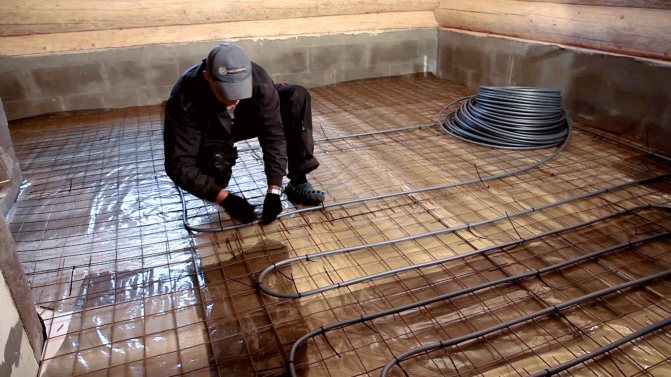

The process of installing a water-heated floor
It is not recommended to turn on underfloor heating in a screed until the screed is completely dry, which is about 30 days.
If the screed is laid on a wooden floor, then this in itself is a real problem. A wooden base, moreover, under the influence of high temperature, and even more so in violation of technology, will quickly become unusable, collapsing the entire system at any time.
The reasons are quite weighty, so in certain cases it is better to give preference to dry technologies, and if the problem is solved independently, then such a technology may not be as costly as it seems. The most expensive element is metal plates, but it is not difficult to make them yourself. It is better if aluminum is used as a material for manufacturing. The only problem is to bend the metal so that you get grooves for laying pipes.
An option for installing a polystyrene-based underfloor heating system, made using "dry" technology, is presented in the video.
Water heat-insulated floor on a wooden base - Part 2 - Laying the contours
Collector installation
The manifold must contain a sufficient number of outputs to connect all circuits.
The same goes for return manifold. In its simplest form, it contains only the valves required for one-way water flow.
Availability servos allows the opening or closing of valves.
The thermostat makes it possible to set a certain temperature and subject it to regulation. It is connected to the valves by means of controllers and is brought out to a place accessible to users by the system.
Place the thermostat away from drafts, cold or hot air currents for adequate information transfer.
The collector is installed at a height 50 cm on a wall bracket or in a special box mounted in the wall. The pipes fit into the corner clip and are secured with Euro cones.
To install the thermostat, you need a 1.5-3 m cable and presence of an outlet nearby with its location.
Not sure how to calculate the consumption of water-based ceiling paint? We will help.
You can see various options for lighting the ceiling in the kitchen here.
Photos of examples of a white kitchen with a black countertop are at this address: https://ru-remont.com/kuhnya/stoleshnitsy/stoleshnitsy-dlya-kuhni-foto-obzor.html
The nuances of pouring screed for a water floor
There are a number of features in creating a screed on top of a warm water floor system.Such nuances are associated with the distribution of heat along its thickness and in the form of the floor covering, which is planned for installation.
- Filling is performed only when the working pressure is on in the pipes (for more details: "It is important to know: how to fill the warm water floor").
- Not earlier than 4 weeks after the screed is poured, it is considered ready and only after that you should start creating the floor covering.
- In the event that the installation of a warm water floor is performed under a tiled floor, then the required screed thickness is about 3-5 centimeters. They also use the method of distributing pipes in compliance with a gap equal to 10-15 centimeters, performing the installation of a warm floor on the ground. If you do not follow these recommendations of specialists, the heat coming from the pipes will not warm up properly, the floor space between them, as a result of which the so-called "thermal zebra" effect appears on the surface of the finished floor - this is when, when moving along the surface, a person's foot clearly feels the alternation bands of heat and cold.
- If the owner of the premises intends to lay laminate or linoleum, the screed is formed of a smaller thickness. In this case, to increase the strength, an additional reinforcing mesh is used, which is placed on top of the underfloor heating system under the laminate. This reduces the heat path from the pipes of the system to the surface of the finished floor covering. In addition, there is no need to lay a heat-insulating layer under the laminate, since then the efficiency of the heating system will decrease.
- They turn on the water floor heating system when the first autumn cold weather sets in. Property owners should take into account that the initial warming up takes several days, and only after that the created structure will maintain the set temperature due to its high inertness. The system can also be kept at low power in working order throughout the year by turning off some circuits and leaving only those that are involved in heating rooms (baths, toilet, hallway), where ceramic tiles or self-leveling floors are used as flooring. They remain cold to the touch even in the heat.
Hydraulic pressure testing of the system
After connecting the pipes into a single system it is necessary to check their strength and tightness. To do this, they are completely filled with water and air is released. The working capacity of all valves is monitored, pipes are visually checked for leaks.
Re-pressure testing is carried out after connecting the pump and barometers.
After the floor is filled with concrete, the pipes will be under pressure up to 30-40 MPa. Pressure testing is carried out under pressure, in 1.5 times the working, which is 60 MPa.
For this shut off all manifold valves and pump air or liquid into the pipes. The pump is pumped with water for 30 minutes, the pressure is controlled several times in the period from 1 to 2 hours with the pump turned off. A drop in the indicator is acceptable in 2 hours at 20kPa.
Advantages and disadvantages
The advantages of such floors include their relative cost-effectiveness. Indeed, in most cases, for the operation of this system, full-fledged heating boilers will be used, the efficiency of which is much higher than electric floor heating systems. In addition, if you use underfloor heating throughout the entire area of a house or apartment, it will work as the main or additional element of the heating system. Thus, the water heat-insulated floor makes the floor covering not only pleasant and warm to the touch, but also warms the house to some extent.
There are also disadvantages here, but they are more likely not related to operational qualities, but to economic ones. After all, the average cost of materials for a water floor is about 1,500 rubles per square meter.This does not include work. If you order a "turnkey" floor installation, the price per square meter will rise to 2000-3000 rubles per sq.m. That is why our article will help you save a rather serious amount of money, because all the work can be done quite efficiently with your own hands.
A calculator that will calculate the approximate cost of materials for you based on the required area:
Do-it-yourself installation and connection of a gas boiler and a pump for underfloor heating
A standard boiler, operating on gas and serving to supply hot water and space heating, has 5 outlets arranged in series from left to right:
- Hot water outlet to the heating system.
- Hot water outlet to the water supply system.
- Gas supply.
- Cold water inlet for heating and supply.
- Cold water inlet from heating (return).
Connections of all pipes to the heating element detachable, are installed using couplings and nuts.
The heating system is controlled separately from the water supply, which makes it possible to connect independently.
In the boiler from the collector of a warm water floor must be suitable two tubes. One will supply cooled water, and the other will supply hot water to the heating system.
The pump is included in most modern boilers. If it is absent, it is necessary to install it in series with a manifold and a heater.
It is recommended to place the pump between return system collector and pipe inlet to the boiler. It is possible to install separate pumps for each circuit.
Elements of a warm water floor
A warm water floor in a screed is very popular because it has a high heat transfer, which means that it has a higher efficiency. A heated screed to a certain temperature is capable of retaining heat for a long time if it is made using the entire technology. The main thing is to know what materials are needed for such a floor and in what sequence to mount them. The figure below shows a diagram of a warm water floor in a screed.
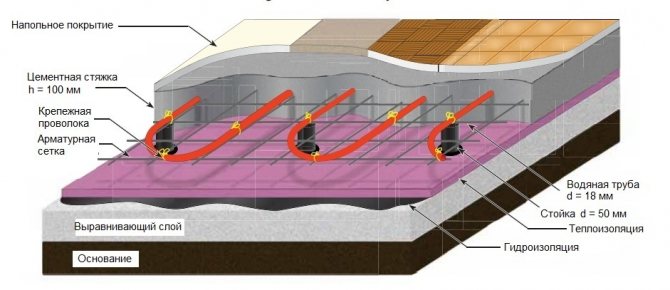

Scheme of a warm water floor with a screed
First of all, preparatory work should be carried out, which are aimed at leveling the base, since it is better to lay the insulation on a flat base for greater efficiency. As a rule, the base is a rough screed, after which the formation of all layers of the warm floor begins. Naturally, after the rough screed has completely dried.
The process consists of the following technological stages:
- A damper tape is fixed around the perimeter of the room, which represents a strip of thermal insulation. Its purpose is to prevent the transfer of heat from the floor to the walls, therefore it is attached along the perimeter to the walls. The second purpose is to compensate for the thermal expansion of a heated floor with a screed when heated. As a tape, you can use pieces of foam, no more than 1 centimeter thick, or a special tape. Other options are also possible, as there are many of them.
- The next stage consists in laying on the base (rough screed) thermal insulation based on expanded polystyrene with a density of up to 35 kg / m2. This material is more preferable because it is able to withstand significant mechanical loads, and also has excellent thermal insulation properties, despite its high cost. If you use a cheaper foam, then it has a number of disadvantages.
Cement screed for underfloor heating. Insulation for a warm floor.
- The thickness of this layer depends on a number of factors that must be taken into account: region, characteristics of the material, floor, structural features of the building, etc.
- The desired element of the system is a reinforcing mesh with cells of 50x50 mm. This is especially true for large areas. The mesh is attached to the pipes with special plastic brackets.
- Then the screed is poured over the beacons to get a flat surface. The thickness of the screed over the pipes is not more, but not less than 3 cm.The surface must be level enough to fit any kind of floor covering.
- The floor covering is laid on a perfectly flat base. The main thing is that it can be used in underfloor heating systems.
The technology for arranging a warm floor does not contain problematic stages, therefore, it is available for anyone who wants to have warm floors at home in one or several rooms.
Features of pipes and their laying patterns
Pipes are considered the main elements of underfloor heating, so their choice should be taken with full responsibility. Mostly polymer pipes are used and much less often, especially nowadays - metal-plastic ones. Such pipes are characterized by high adaptability and durability. Moreover, they have one very significant drawback associated with low thermal conductivity. More recently, corrugated stainless steel pipes have appeared, which have a fairly high thermal conductivity.
As a rule, the diameter of pipes is 16-20 mm, and their laying is carried out according to one of the schemes shown in the figure below.
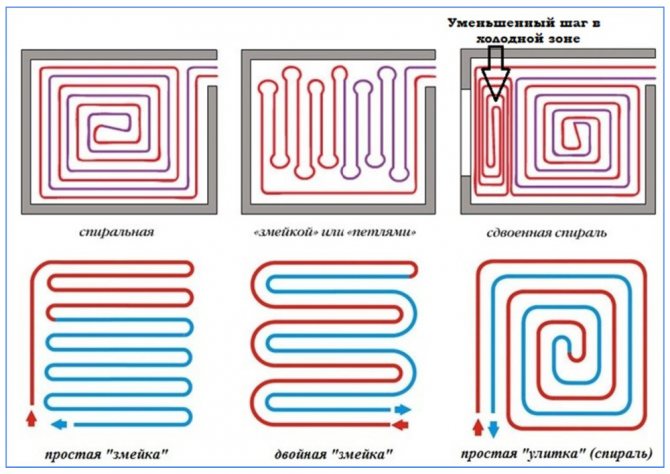

Schemes for laying pipes for a warm water floor
Laying with a snake is considered the simplest, but not very effective, since the snake has a significant length and the temperature of the carrier at the exit is much lower than the temperature at the inlet. Despite this, this feature can be used for its intended purpose, starting from the area for which more intense heating is important.
The double snake and spiral do not have this disadvantage, but their styling is more complicated. Before starting the installation, it is better to draw a diagram so as not to get confused where the entrance is and where the exit is.
The nature of the screed
To fill the screed, the most common solution is used, based on sand and cement, grade M-400 or M-500. If ready-made concrete is used, then its grade must be at least M-350.


Semi-dry screed for underfloor heating
Despite this, there is one caveat here. This is due to the fact that ordinary "wet" solutions gain their strength within 1 month, while it is not recommended to turn on underfloor heating. If you start to dry the screed forcibly, then cracks may appear that can break the pipes. In this case, the best option is the use of semi-dry screeds, in which various additives are present that increase the plasticity of the solution, and a small amount of moisture reduces the aging time of the solution. Such a solution can be prepared by yourself if you purchase ready-made additives, or you can use ready-made mixtures, but they will cost much more, although the hassle with them is much less.
Do-it-yourself water floor heating
Is it possible to make a warm floor in an apartment?
As for legal issues, the first thing you need to learn is that you cannot connect directly to the CHP. In no case. So you will make things worse not only for your neighbors, but also for yourself. The pipes are not designed for the heat transfer medium of the CHPP with its pressure.
As for legal issues, in Russia it is forbidden to use water systems for underfloor heating in apartment buildings. This is primarily due to the fact that people foolishly connect directly to the CHP. Whether this can be done through a heat exchanger needs to be clarified. In other countries, this problem is not observed.
Our verdict is that you can make a warm floor in an apartment. But our verdict is not a verdict of the legislation of a particular country

